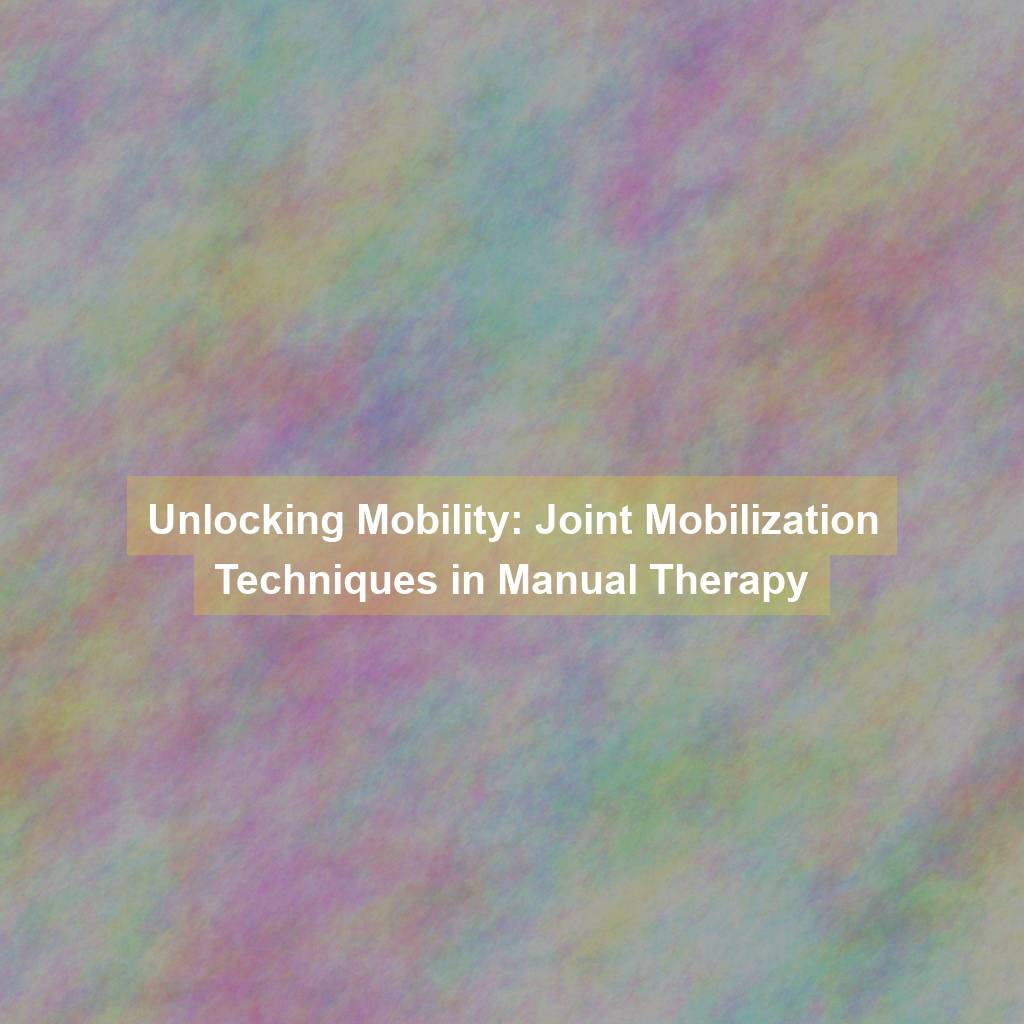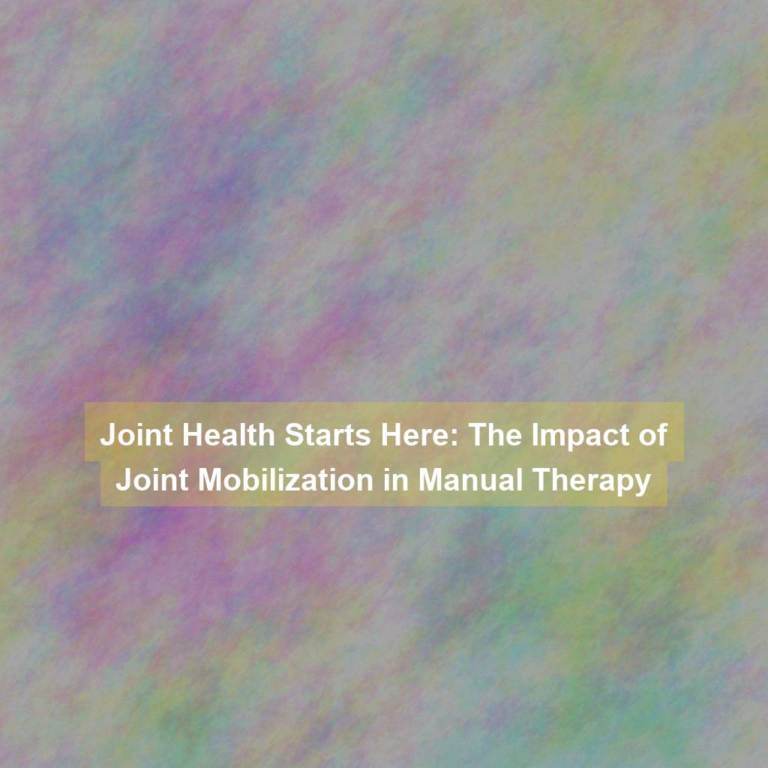You may be skeptical about the effectiveness of joint mobilization techniques in manual therapy. However, when performed by a skilled practitioner, these techniques can be a valuable tool in improving joint function and reducing pain.
Many individuals have found relief and increased mobility through these methods, making it worth exploring how they could benefit you or your clients. Understanding the principles and applications of joint mobilization can provide valuable insight into the potential of this approach.
As you consider the possibilities, you’ll discover how these techniques can make a meaningful impact on overall well-being and quality of life.
Understanding Joint Mobilization Techniques
To understand joint mobilization techniques, it’s important to grasp the underlying principles and mechanics involved in this manual therapy method. Joint mobilization aims to restore normal joint function by applying precise forces to the joint. The therapist uses skilled passive movements to alleviate pain, improve joint mobility, and facilitate tissue repair.
Understanding the biomechanics of joint mobilization is crucial. By applying controlled forces, the therapist can target specific tissues within the joint to promote healing and reduce pain. Additionally, comprehending the physiological effects of joint mobilization is essential. This technique can stimulate the body’s natural healing process by increasing blood flow to the area, reducing inflammation, and promoting tissue repair.
Furthermore, understanding the indications and contraindications of joint mobilization is vital. This knowledge ensures that the technique is applied safely and effectively, taking into account the patient’s specific condition and needs. Ultimately, by understanding the principles and mechanics behind joint mobilization, therapists can administer this manual therapy method with precision and confidence, optimizing the recovery process for their patients.
Indications for Joint Mobilization
You should consider joint mobilization when assessing a patient’s restricted joint mobility and pain symptoms. It’s an effective manual therapy technique used to address musculoskeletal dysfunction, including joint hypomobility, muscle tightness, and pain. Joint mobilization can be indicated for various conditions such as osteoarthritis, ligamentous sprains, muscle strains, and post-operative stiffness. Additionally, it’s beneficial for individuals with restricted range of motion due to chronic conditions or prolonged immobilization. When a patient presents with joint stiffness, difficulty with movement, or pain during specific activities, joint mobilization can be a valuable intervention to restore normal joint function and alleviate discomfort.
Furthermore, joint mobilization is recommended for patients who haven’t responded to initial conservative treatments such as rest, ice, and exercise therapy. It can be particularly beneficial for individuals who experience pain and functional limitations despite engaging in therapeutic exercises and activity modifications. In such cases, joint mobilization can help improve joint mechanics, reduce pain, and facilitate the return to daily activities and sports participation.
Techniques for Joint Mobilization
When performing joint mobilization, it’s essential to apply specific techniques with controlled, graded force to the affected joint.
One commonly used technique is the oscillatory movement, where the joint is gently moved back and forth within its available range. This helps to reduce pain, improve joint nutrition, and promote tissue healing.
Another effective technique is sustained stretching, in which the joint is slowly and steadily pushed to its end range and held for a period of time. This helps to increase joint flexibility and reduce stiffness.
Additionally, a skilled manual therapist may employ manipulation techniques, which involve a quick, targeted thrust to restore normal joint function and range of motion. These techniques should always be performed with precision and caution, taking into account the patient’s comfort and response.
It’s crucial to undergo proper training and practice under supervision to master these techniques and ensure their safe and effective application. Remember, each technique should be tailored to the specific needs and condition of the individual patient for optimal outcomes.
Considerations for Joint Mobilization
As joint mobilization techniques are employed, it’s crucial to consider the specific needs and condition of the individual patient for optimal outcomes. One of the primary considerations for joint mobilization is the patient’s medical history. Understanding any past injuries, surgeries, or chronic conditions is essential in determining the appropriate mobilization techniques and forces to be applied.
Additionally, the patient’s current level of pain and discomfort should guide the intensity and duration of the mobilization. It’s important to communicate with the patient throughout the process, ensuring that the mobilization is within their tolerance and comfort levels.
Another vital consideration is the stage of healing the patient is in. Different mobilization techniques may be appropriate for acute injuries compared to chronic conditions. Furthermore, the individual’s age, lifestyle, and activity level must be taken into account when planning joint mobilization. Adjustments to techniques may be necessary for elderly patients or those with sedentary lifestyles.
Considering these factors will help ensure that joint mobilization is tailored to the specific needs of each patient, leading to more effective and personalized treatment outcomes.
Benefits of Joint Mobilization
Joint mobilization techniques offer a range of benefits for individuals undergoing manual therapy, including improved joint flexibility, reduced pain, and enhanced functional movement. By using specific grades of joint mobilization, therapists can target restrictions within the joint capsule and surrounding tissues, leading to increased range of motion and flexibility. This can be particularly beneficial for individuals recovering from injuries or those with chronic musculoskeletal conditions.
Joint mobilization also helps in reducing pain by modulating pain signals and promoting the release of endorphins, the body’s natural pain-relieving hormones. This can result in immediate pain relief and improved overall comfort. Additionally, joint mobilization techniques facilitate enhanced functional movement by restoring normal joint mechanics, which is crucial for activities of daily living and sports performance. Improved joint function can lead to better movement patterns and reduced risk of further injury.
Conclusion
You’ve learned about the importance of joint mobilization techniques in manual therapy and how they can improve mobility and decrease pain. By understanding the indications, techniques, and considerations for joint mobilization, you can effectively incorporate these methods into your practice.
The benefits of joint mobilization are clear, and by utilizing these techniques, you can help your patients achieve better movement and function in their daily lives.
Keep up the great work in unlocking mobility for your patients!







